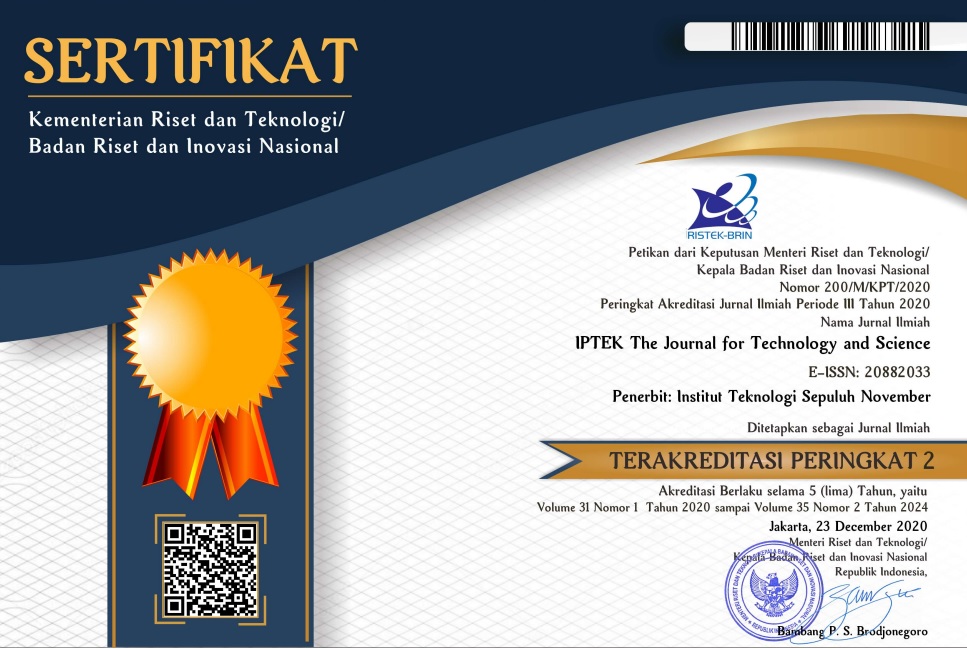Biocompatibility of Silicone Elastomer Incorporated with Chitosan: Morphology, Mechanical, Biodegradation Assessment and the Potential for Injectable Biomaterials
Abstract
Keywords
Full Text:
Full TextReferences
Newell N, Little JP, Christou A, Adams MA, Adam CJ, Masouros SD. Biomechanics of the human intervertebral disc.
Journal of the Mechanical Behavior of Biomedical Materials 2006;p. 1–21. https://www.researchgate.net/publication/
_Biomechanics_of_the_human_intervertebral_disc_A_review_of_testing_techniques_and_results.
Newell N, Little JP, Christou A, Adams MA, Adam CJ, Masouros SD. Biomechanics of the human intervertebral disc:
A review of testing techniques and results. Journal of the Mechanical Behavior of Biomedical Materials 2017;69:84–92.
https://www.sciencedirect.com/science/article/pii/S1751616117300449?via%3Dihub.
Yanagisawa O, Oshikawa T, Matsunaga N, Adachi G, Kaneoka K. Acute Physiological Response of Lumbar Intervertebral
Discs to High-load Deadlift Exercise. Magnetic Resonance in Medical Sciences 2021;20:290–294. https://www.jstage.jst.
go.jp/article/mrms/20/3/20_mp.2020-0052/_article.
Vernengo J, Fussell GW, Smith NG, Lowman AM. Synthesis and characterization of injectable bioadhesive hydrogels for
nucleus pulposus replacement and repair of the damaged intervertebral disc. Journal of Biomedical Materials Research -
Part B Applied Biomaterials (2010) 2010;https://onlinelibrary.wiley.com/doi/10.1002/jbm.b.31547.
Growney Kalaf EA, Pendyala M, Bledsoe JG, Sell SA. Characterization and restoration of degenerated IVD function
with an injectable, in situ gelling alginate hydrogel: An in vitro and ex vivo study. Journal of the Mechanical Behavior of
Biomedical Materials (2017) 2017;https://www.sciencedirect.com/science/article/pii/S1751616117302023?via%3Dihub.
Whatley BR, Wen X. Intervertebral disc (IVD): Structure, degeneration, repair and regeneration. Materials Science and
Engineering C (2012) 2012;32:61–77. https://www.tandfonline.com/doi/full/10.1080/13102818.2017.1332493.
Wang G, Huang L,Wang X. Feasibility of chitosan-alginate (Chi-Alg) hydrogel used as scaffold for neural tissue engineering:
a pilot study in vitro. Taylor and Francis Online 2017;32:1–2. https://www.scopus.com/authid/detail.uri?authorId=
Kweon DK. Preparation and characteristics of chitosan-g-PDMS copolymer. Polymer Bulletin (1998) 1998;6. https:
//link.springer.com/article/10.1007/s002890050413.
Depan D, Kumar B, Singh RP. Preparation and characterization of novel hybrid of Chitosan-g-PDMS and sodium montmorrilonite.
Journal of Biomedical Materials Research - Part B Applied Biomaterials (2008) 2008;https://onlinelibrary.
wiley.com/doi/10.1002/jbm.b.30860.
Ming-Zhe L, Li-FengW, Lei F, Pu-Wang L, Si-Dong L. Preparation and properties of natural rubber/chitosan microsphere
blends. Micro and Nano Letters (2017) 2017;p. 6–7. https://ietresearch.onlinelibrary.wiley.com/doi/10.1049/mnl.2016.
AfandiAN,Yuniarti NH. Hydrofobic analysis of rubber materials on high voltage insulation. TEKNOJournal 2007;3. https:
//www.researchgate.net/publication/261872392_Hydrofobic_analysis_of_rubber_materials_on_high_voltage_insulation.
Mente P, Tshwafo M. Natural Rubber and Reclaimed Rubber Composites–A Systematic Review. Polymer Science U
S S R 2016;19 No. 9. https://www.researchgate.net/publication/307612931_Natural_Rubber_and_Reclaimed_Rubber_
Composites-A_Systematic_Review.
Mark JE. Polymer Data Handbook: Second Edition. Oxford Academic 2009;https://academic.oup.com/book/52773.
GaylordMW. Reinforced Plastics, Theory and Practise. 2nd edition Massachusets: Chaner Books 1974;https://openlibrary.
org/books/OL5048981M/Reinforced_plastics_theory_and_practice.
Wilke HJ, Neef P, Caimi M, Hoogland T, Claes LE. New in vivo measurements of pressures in the intervertebral disc
in daily life. Spine 1999;24 No. 8:755–762. https://journals.lww.com/spinejournal/abstract/1999/04150/new_in_vivo_
measurements_of_pressures_in_the.5.aspx.
Kanter JC. The use of RTV silicones in maxillofacial prosthetics. The Journal of Prosthetic Dentistry (1970) 1970;24 No.
:646–653. https://www.sciencedirect.com/science/article/pii/0022391370901010?via%3Dihub.
Li P, Jiang S, Yu Y, Yang J, Yang Z. Biomaterial characteristics and application of silicone rubber and PVA hydrogels
mimicked in organ groups for prostate brachytherapy. Journal of the Mechanical Behavior of Biomedical Materials (2015)
;49:220–234. https://www.sciencedirect.com/science/article/pii/S1751616115001794?via%3Dihub.
Zhang Z, Cui H. Biodegradability and biocompatibility study of poly(chitosan-g-lactic acid) scaffolds. Molecules (2012)
;17 No. 3:3243–3258. https://www.mdpi.com/1420-3049/17/3/3243.
Elsawy MA, Kim KH, Park JW, Deep A. Hydrolytic degradation of polylactic acid (PLA) and its composites. Renewable
and Sustainable Energy Reviews (2017) 2017;79:1346–1352. https://www.sciencedirect.com/science/article/pii/
S1364032117307876?via%3Dihub.
Wang G, Li P, Peng Z, Huang M, Kong L. Formulation of vanillin cross-linked chitosan nanoparticles and its characterization.
Advanced Materials Research (2011) 2011;335-336:474–477. https://www.scientific.net/AMR.335-336.
Yan J, Yang L, Wang G, Xiao Y, Zhang B, Qi N. Biocompatibility evaluation of chitosan-based injectable hydrogels for
the culturing mice mesenchymal stem cells in vitro. Journal of Biomaterials Applications (2010) 2010;24 No. 7:625–637.
https://journals.sagepub.com/doi/10.1177/0885328208100536.
Keong LC, Halim AS. In Vitro models in biocompatibility assessment for biomedical-grade chitosan derivatives in wound
management. International Journal of Molecular Sciences (2009) 2009;10 No. 3:1300–1313. https://www.mdpi.com/
-0067/10/3/1300.
Li H, Zhou C, Zhu M, Tian J, Rong J. Preparation and Characterization of Homogeneous Hydroxyapatite/Chitosan Composite
Scaffolds via In-Situ Hydration. Journal of Biomaterials and Nanobiotechnology (2010) 2010;1 No. 1:42–49.
https://www.scirp.org/journal/paperinformation?paperid=3006.
Liu M, Zhang Y, Wu C, Xiong S, Zhou C. Chitosan/halloysite nanotubes bionanocomposites: Structure, mechanical
properties and biocompatibility. International Journal of Biological Macromolecules (2012) 2012;51 No. 4:566–575.
https://www.sciencedirect.com/science/article/pii/S0141813012002383?via%3Dihub.
Hambali M, Wijaya E, Reski A. Pembuatan Kitosan dan Pemanfaatannya sebagai Agen Koagulasi-Flokulasi. Jurnal
Teknik Kimia (2017) 2017;23 No. 2:104–113. https://www.mendeley.com/search/?page=1&query=Sebagai%20Agen%
Koagulasi-Flokulasi&sortBy=relevance.
ChuangWY, Young TH, Yao CH, ChiuWY. Properties of the poly(vinyl alcohol)/chitosan blend and its effect on the culture
of fibroblast in vitro. Biomaterials (1999) 1999;20 No. 16:1479–1487. https://www.sciencedirect.com/science/article/pii/
S014296129900054X?via%3Dihub.
Costa-Pinto AR, Martins AM, Castelhano-Carlos MJ, Correlo VM, Sol PC, Longatto-Filho A, et al. In vitro degradation
and in vivo biocompatibility of chitosan-poly(butylene succinate) fiber mesh scaffolds. Journal of Bioactive and Compatible
Polymers (2014) 2014;29 No. 2:137–151. https://journals.sagepub.com/doi/10.1177/0883911514521919.
Tamara FR, Lin C, Mi FL, Ho YC. Antibacterial effects of chitosan/cationic peptide nanoparticles. Nanomaterials (2018)
;p. 1–15. https://www.mdpi.com/2079-4991/8/2/88.
DOI: http://dx.doi.org/10.12962%2Fj20882033.v35i3.22015
Refbacks
- There are currently no refbacks.
IPTEK Journal of Science and Technology by Lembaga Penelitian dan Pengabdian kepada Masyarakat, ITS is licensed under a Creative Commons Attribution-ShareAlike 4.0 International License.
Based on a work at https://iptek.its.ac.id/index.php/jts.


